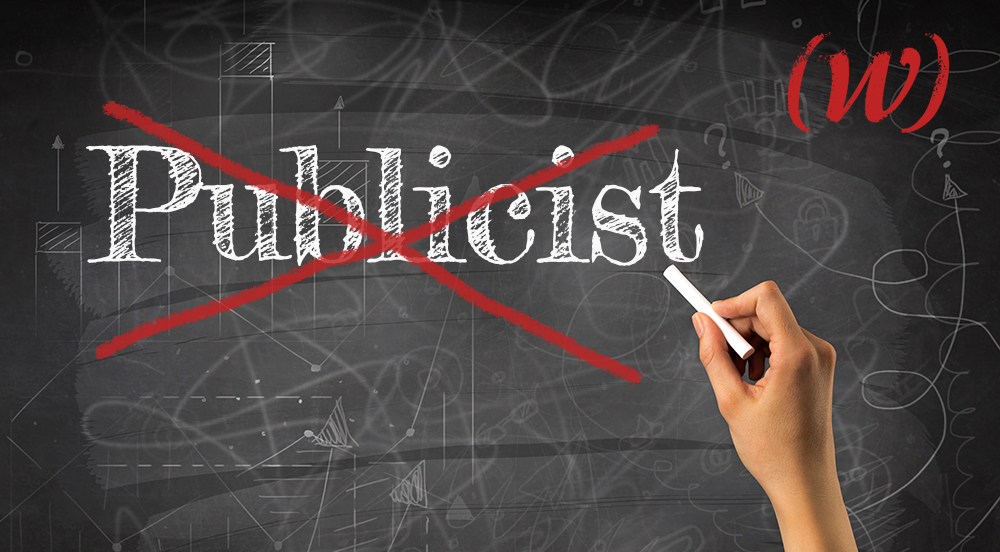By Julie Wright —President
Twitter: @juliewright
Has your mom ever used your childhood nickname in front of your adult friends? That’s how I feel when someone uses the term publicist or publicity to describe my work.
Generating positive media coverage is definitely among the many functions performed by a public relations professional. But the word “publicist” says nothing of the research, strategy, messaging and many other thoughtful, and even artful, activities that go into a successful public relations program. The word, in my opinion, minimizes my work.
For that reason, I would like to see “publicist” buried next to “flack” and “spin doctor.”
Public relations professionals are strategic communicators.
Two years ago, PRSA’s 2017 Chair, Jane Dvorak, addressed the PRSA Western District Conference in Riverside, Calif. urging attendees to see themselves as leaders, strategists and analysts. To my ear, “publicist” is a label that says none of those things. Two years later, I continue to hear this term applied to describe work that is only about 10-20 percent producing media coverage.
If you’re not convinced that “publicist” needs to go, give these four points careful consideration, and let me know if they help change your thinking. (If you already agree, these may help you convert or at least educate others.)
1. Publicists Produce Transactions. PR Pros Build Relationships.
We work in a very transactional environment today. Marketing and communications outcomes are boiled down to clicks, likes, links and conversions, but the stakeholders who need to receive your messages are not clicks and conversions—they’re real human beings who crave meaningful emotional connections with other real human beings.
This absolutely includes journalists.
Media databases like Cision and Meltwater make it much easier to build a big list than a targeted one. Journalists become email addresses and not people. Instead of building a relationship with the media, this transactional approach plays a numbers game. Ultimately, when the media gripes about getting a PR pitch addressed to the wrong name or that’s a country mile off the mark, it’s because they’re not being communicated to as human beings.
Public relations requires building understanding, changing perceptions and motivating behaviors and beliefs. Those kinds of outcomes need a relational versus transactional approach, which requires understanding your audiences and treating them as humans. This can be accomplished through surveys, interviews and focus groups and using that information to create personas.
Publicity is just too limiting a term to encompass these approaches.
2. Publicity is a Tactic. Public Relations Requires Strategy.
As public relations professionals, we can’t fulfill our role and responsibilities with a tactical mindset. We must think strategically.
From research to message development and testing to creative—strategy drives the choices we make, and those choices drive our campaign results. Did we communicate in a manner that earned our audience’s attention and resonated with them so that their perceptions, beliefs and behaviors were impacted?
I equate publicity with none of the above. Instead, I picture someone producing a bunch of press clippings which is useful if stroking your client’s ego is the only goal of your campaign.
3. A Publicist’s Communication is One-Way. PR Requires Listening.
There is far more pitching, posting and publishing than listening on social media and the web these days. I like the term coined by Mark Schaefer five years ago, Content Shock, to sum up the impact of content marketing run rampant. Schaefer pointed out then how the pace and volume of content being produced far exceeded the pace and volume of content being consumed.
Anyone today who is pushing content or a message without creating a way for the recipient to engage, respond and be heard is missing a huge opportunity to build relationships.
Communicators who create space for their stakeholders to be heard are the ones doing it right. When a crisis hits, they’ll be able to engage in conversations with their customers or investors rather than an avalanche of angry or outraged Tweets and Facebook posts.
The brands that weather crises more easily than others are those that have built relationships and goodwill with their stakeholders. And those are the brands being stewarded by strategic communicators and not publicists.
4. Publicity is About Earned Media. Public Relations Crosses All Media.
A decade ago, traditional media outlets underwent an implosion, while podcasts, online videos, blogs and social media storytelling platforms exploded. In the aftermath of these two trends, traditional media gatekeepers like the daily newspaper or evening newscast have lost their ability to influence public perception at scale.
Earned media was once the bread and butter of the public relations function, but today, it is just one of several communication platforms our profession employs to reach and engage with its stakeholders.
The contemporary integrated approach, sometimes referred to as the PESO Model, combines paid, earned, shared and owned media. Paid media can include social media ads and boosting or Google AdWords. Earned media includes press coverage but can include analyst relations, awards and speaking opportunities that imply and/or impart third-party validation. Shared media refers to social networks like Facebook but also review sites like TripAdvisor and Yelp. Owned media describes all of the creative assets at your disposal to engage your audiences and to interact with them directly including print, digital and multimedia content.
Publicity is a component of only one of those four platforms, making it an inadequate label for describing what today’s strategic communicators do.
So, Let’s Retire the Term Publicist and Champion the Role of Strategic Communicator.
It’s time to toss this transactional, tactical, and out-of-touch term. It’s old school and perpetuates a narrow stereotype of what public relations today actually is. Publicity is about as apropos to what my team and I do every day at (W)right On Communications as my childhood nickname is to my adult identity. Now, if only I could get my mom to stop calling me Oobies.
















